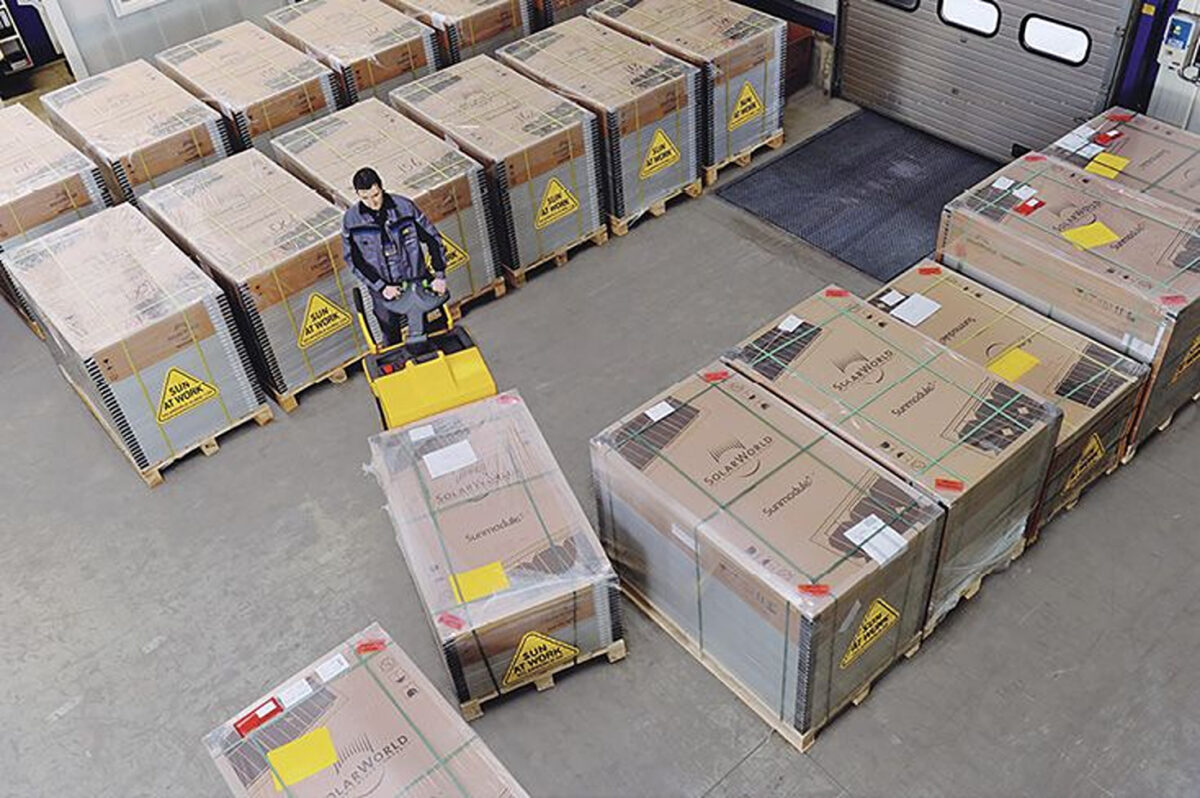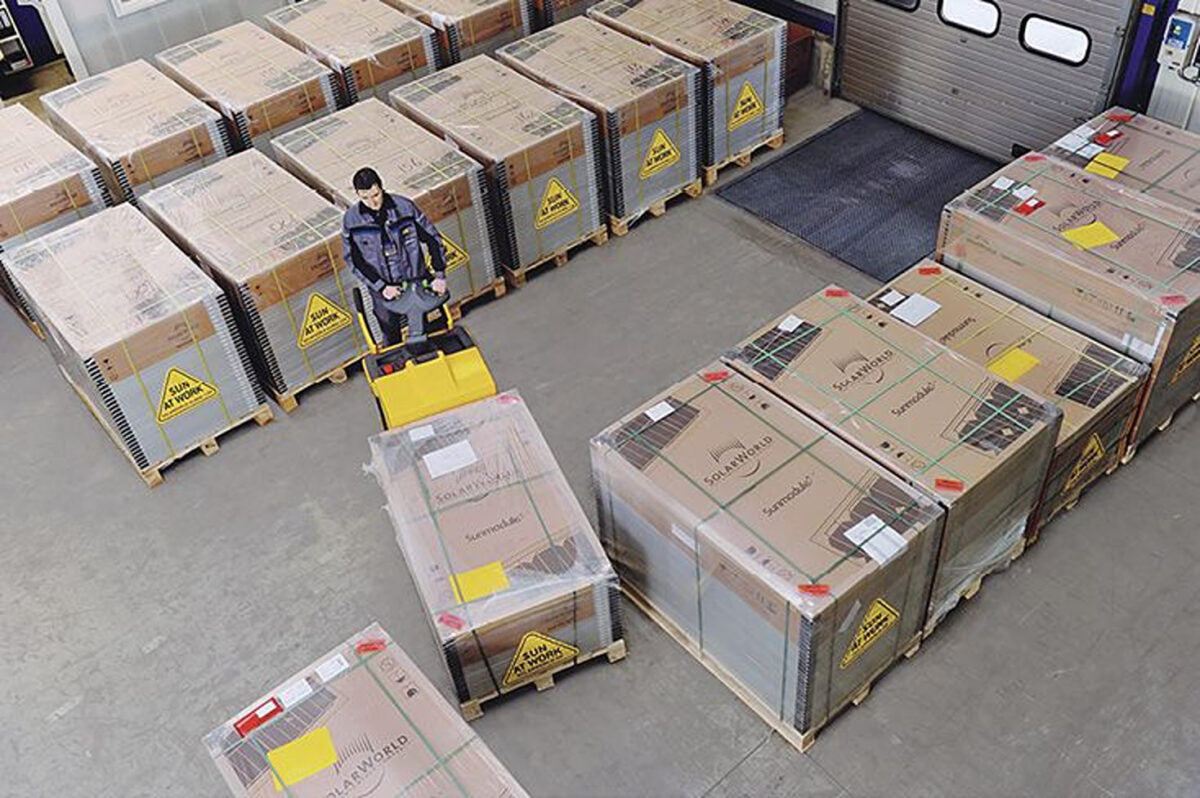https://www.pv-magazine.com/2024/05/23/solar-buyers-market-but-us-developers-face-price-premium/
US solar prices double European costs amid regulatory challenges

If PV modules spend too long in warehouses, developers run the risk of the technology becoming outdated in a rapidly evolving market.
Image: SolarWorld Logistik
The past two years have seen a surge in PV module production. Clean Energy Associates (CEA) expects a 15% increase in annual solar production capacity to May 2025, versus around 8% more demand.
Several factors have contributed to this imbalance. The prospect of additional antidumping and countervailing duties (AD/CVDs) from the US government, with new countries potentially affected, further complicates the picture for solar module buyers.
With an election scheduled in the United States in November 2024, there may be further policy upheaval.
Tariff changes
Developers have enjoyed falling prices for the first time in a while but new tariffs could drive up US prices despite plentiful supply.
The biggest global solar module manufacturers are accommodating UFLPA restrictions to ship more product than anticipated and US module production is expanding. New manufacturers based in the United States and other nations unaffected by AD/CVDs – such as Türkiye and Indonesia – would take time to adapt to new trade policy, as happened after the UFLPA’s introduction.
Solar developers might need new suppliers and will have to double down on quality assurance and factory acceptance testing to ensure quality.
Technology in transition
The industry is in the midst of a transition from passivated emitter rear cell (PERC) to tunnel oxide passivated contact (TOPCon) solar. Heterojunction (HJT) solar is changing, even in PERC modules, with new materials making panels more weather resilient. Developers have historically struggled to purchase insurance for projects in hailstorm-hit areas such as Texas. Now, a film can be applied to PV module glass during production to strengthen products. Such technological shifts add additional risk to supply agreements, however.
Favorable terms
After a 24-month to 36-month seller’s market, a turnaround could reopen favorable terms and conditions for buyers. When manufacturers held the upper hand, developers had a tough time persuading them to be importers of record, and thus responsible for getting products across borders by meeting US Customs and Border Protection (CBP) UFLPA traceability requirements. When shipments are detained, the importer of record is the responsible party.
If the buyer is the importer of record, they could face paying for products stuck in customs. If the supplier is responsible, payments don’t have to be made until panels are in-country.
The buyer could integrate a Delay Liquidated Damages clause in the supply contract to avoid such a scenario. If a shipment is delayed because it did not pass CBP requirements at the border, the seller would then have to reimburse the buyer for the additional costs incurred.
Popular content
Developers have to ask themselves, “If I do decide to lock in pricing, will these modules sit in warehouses for a long time?” That is one of the downsides of pre-planning and purchasing at lower prices. If a project is delayed, modules sit in warehouses where they may be repeatedly moved on forklifts, potentially causing damage. Developers can negotiate terms to limit risk associated with long-term storage, however.
There is also the risk of technology becoming outdated. Developers have learned the hard way in the past that when they have saved up a lot of equipment – transformers and modules – it has sometimes turned out that projects were canceled or delayed long enough for technology to evolve and for their product to become obsolete. As a result, developers have had to resell equipment for a fraction of the price they paid for it.
Regulatory uncertainty
Policy uncertainty presents another challenge. What will happen in the upcoming US presidential election and how will that affect solar equipment supply and production levels? Developers have to plan for that uncertainty as well as thinking about keeping their projects on schedule.
The current surge in supply has occurred in such a brief period of time because of the tax credit incentives embodied in the US Inflation Reduction Act (IRA) and because manufacturers are setting up facilities within the United States to avoid import restrictions.
The project development and construction worlds are currently not moving as fast as solar production and manufacturing. Even as challenges mount on the development side – projects are delayed, finance falls through, and planning regimes change – manufacturers are still moving forward at full speed.
The dynamics in Europe versus the United States are very different right now because of the UFLPA. There is no similar restriction in place yet in Europe, so the continental market is awash with low-cost modules. The pricing environment is in flux. Prices in Europe have dipped as low as $0.11/W of panel generation capacity. Prices in the United States still hover at around $0.24/W.
That difference in price is being sustained because many panel makers cannot yet export into the United States, as they are still trying to figure out the UFLPA import process. The industry is essentially setting up a differentiated North American supply chain.
Products may run through the same facilities but suppliers carefully segregate those that require full traceability to go to the United States. Many modules sitting in warehouses in Europe lack the full traceability required for United States import.
 About the author: Engilla Draper is an expert in procurement and supply chains at Clean Energy Associates, which provides advisory services to developers and manufacturers in the renewables industry.
About the author: Engilla Draper is an expert in procurement and supply chains at Clean Energy Associates, which provides advisory services to developers and manufacturers in the renewables industry.
The views and opinions expressed in this article are the author’s own, and do not necessarily reflect those held by pv magazine.
This content is protected by copyright and may not be reused. If you want to cooperate with us and would like to reuse some of our content, please contact: editors@pv-magazine.com.



